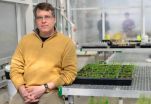(Press-News.org) STANFORD, Calif. — In 2005, a Stanford University scientist discovered how to switch brain cells on or off with light pulses by using special proteins from microbes to pass electrical current into neurons.
Since then, research teams around the world have used the technique that this scientist, Karl Deisseroth, MD, PhD, dubbed "optogenetics" to study not just brain cells but heart cells, stem cells and the vast array of cell types across biology that can be regulated by electrical signals — the movement of ions across cell membranes.
Optogenetics gave researchers a powerful investigational technique to deepen their understanding of biological system design and function in animal models. But first-generation optogenetics had a shortcoming: Its light-sensitive proteins were potent at switching cells on, but less effective at turning them off.
Now in a paper culminating years of effort, Deisseroth's team has re-engineered their light-sensitive proteins to switch cells off far more efficiently than before. The paper will be published April 25 in Science.
"This is something we and others in the field have sought for a very long time," said Deisseroth, senior author of the paper and professor of bioengineering and of psychiatry and behavioral sciences.
Thomas Insel, MD, director of the National Institute of Mental Health, which funded the study, said this improved "off" switch will help researchers to better understand the brain circuits involved in behavior, thinking and emotion.
"This latest discovery by the Deisseroth team is the kind of neurotechnology envisioned by President Obama when he launched the BRAIN Initiative a year ago," Insel said. "It creates a powerful tool that allows neuroscientists to apply a brake in any specific circuit with millisecond precision, beyond the power of any existing technology."
Behind this development lay many years of foundational experiments in the Deisseroth lab to discover how a key optogenetic "on" switch worked so efficiently to stimulate cells, followed by a systematic effort to redesign this molecular machine to turn it into a fundamentally new kind of "off" switch.
"This is a complex story at the interface of science and engineering," said Deisseroth, who is also the D.H. Chen Professor at Stanford and a Howard Hughes Medical Institute investigator.
Proteins are the machinery of life. These gigantic molecules are built out of smaller molecules known as amino acids. Like so many Lego parts, amino acids join to form proteins, and those proteins then interact to perform every marvelous task of life from controlling the muscles in our fingertips to firing the neurons in our brains. With optogenetics, Deisseroth's lab turned a family of proteins known as microbial opsins into a research tool. That story has been told elsewhere, but the result was that optogenetics allowed scientists to fire laser pulses through thin fiberoptics inserted into the brains of animal models. These light pulses triggered the opsins to deliver a stimulating flow of positive ions or an inhibiting pulse of negative ions to control behavior with high precision and specificity.
As more researchers embraced optogenetics, many discoveries were made with both excitatory and inhibitory opsins. But Deisseroth and other scientists began to notice that stimulation was more effective than inhibition. He therefore sought to lay the groundwork for developing new inhibitory tools by delving more deeply into the mechanism by which the excitatory opsins delivered only positive ions.
Conceptually, the mechanism by which the excitatory opsins operate is simple. Light activation causes the opsin to open a channel through the cell membrane; positive ions then flow through this channel like water through a garden hose. Taking advantage of this channel mechanism, Deisseroth and his collaborators made modified versions of the excitatory opsins in 2008. They called these step-function opsins. A single pulse of light was all it took to flip these switches on and keep the channel open. This allowed the ions to continue flowing, which kept the cell in an excited state even after the light was turned off. The continuous flow of ions enabled by these step-function opsins also made the cell many times more light-sensitive. This allowed scientists to excite neurons deep within the brains of animal models without penetrating the tissue with fiberoptics.
In contrast, none of the inhibitory opsins acted as channels. They were all "pumps" moving only a single ion across the membrane for every incoming photon — acting more like a squirt gun than a garden hose. Each incoming photon was like pulling the trigger to deliver a negative ion. But it took another photon, or trigger pull, to deliver the next negative ion, and so on. This pump mechanism was less efficient than a channel mechanism in terms of ions moved per photon. It was also impossible to engineer the inhibitory opsins to stay open. Therefore it took more intrusive use of light to perform experiments. Finally, the inhibitory pump did not work in the same way as the normal mechanisms that inhibit brain cells. The normal mechanisms make neuron membranes leaky — like water balloons with pinpricks — and more resistant to firing. All these factors made opsin pumps less efficient as inhibitors. Ideally, bioengineers wanted an inhibitory opsin that functioned like a channel.
In a 2012 article in Nature, Deisseroth's team (with collaborator Osamu Nureki, PhD, director of biological sciences at the University of Tokyo) completed the first big step along the path toward improving optogenetic inhibition when they revealed the detailed structure of the on-switch channel protein. This work showed that the amino acids inside the channel pore created a lining of negative charges. This negative lining attracted positive ions to flow through the membrane in order to excite the cell. This discovery pointed to a potential strategy to create an inhibitory channel: bioengineer the opsin to create an inner lining of positive amino acids to draw a flow of negative (inhibitory) ions, such as chloride, into the cell.
From that point, it took roughly another two years for Deisseroth's team, led by Andre Berndt, PhD, and Soo Yeun Lee, PhD, postdoctoral scholars in bioengineering and lead authors of the paper, to complete this process. In order to create this new lining, the Stanford team re-engineered the excitatory channel opsin from their 2012 experiment to change nine of the protein's roughly 300 amino acids. When trigged by light, this newly bioengineered protein now opened a channel lined by more positively charged amino acids, and thereby attracted a flow of negative (chloride) ions to inhibit activity. This created a microbial opsin capable of delivering a powerful channel effect for inhibition.
Finally, fulfilling one of the most anticipated goals of the project, they changed a 10th amino acid, which gave them the ability to keep this new negative channel open — making the negative channel more like the positive channel. As hoped, this created a vastly more light-sensitive inhibitory channel opsin. The targeted neurons remained off for several minutes after a single, brief, blue light pulse, in a manner that was instantaneously reversible with red light. Deisseroth called this new negative channel opsin SwiChR.
As the Stanford team continues a 10-year journey that began with its first microbial opsin experiments in neurons, Deisseroth anticipates that the long-acting and stable responses of SwiChR will open new realms of opportunities for optogenetics.
His enthusiasm was echoed by Merab Kokaia, PhD, a professor at Lund University Hospital in Sweden who has used optogenetics to study epilepsy, among other conditions, in rodent models. Kokaia, who was not involved in the Deisseroth team's new study, noted the new opsin's main advantages: more effective at inhibiting neuronal activity based on chloride conductance, greater sensitivity to light, and the ability to stay open for longer periods and maintain inhibition even without light for longer periods.
"These features could be much more useful for behavioral studies in animals but could also become an effective treatment alternative for neurological conditions where drugs do not work, such as some cases of severe epilepsy and other hyper-excitability disorders," Kokaia said. "The novel approach of channel engineering used by Deisseroth's lab opens unprecedented perspectives for developing new optogenetic tools for system neuroscience studies that will help us to understand better how the brain works."
Charu Ramakrishnan, a research assistant in the Deisseroth lab, also was a co-author of the paper.
INFORMATION:
The research was supported by the National Institute of Mental Health, the Simons Foundation, the National Institute on Drug Abuse, the Defense Advanced Research Projects Agency, the Gatsby Foundation, and the Wiegers Family Fund.
Information about Stanford's Department of Bioengineering, which also supported the work, is available at http://bioengineering.stanford.edu. The department is jointly operated by the School of Engineering and the School of Medicine.
The Stanford University School of Medicine consistently ranks among the nation's top medical schools, integrating research, medical education, patient care and community service. For more news about the school, please visit http://mednews.stanford.edu. The medical school is part of Stanford Medicine, which includes Stanford Hospital & Clinics and Lucile Packard Children's Hospital Stanford. For information about all three, please visit http://stanfordmedicine.org/about/news.html.
Print media contact: Tom Abate at (650) 736-2245 (tabate@stanford.edu)
Broadcast media contact: M.A. Malone at (650) 723-6912 (mamalone@stanford.edu)
Stanford team makes switching off cells with light as easy as switching them on
2014-04-24
ELSE PRESS RELEASES FROM THIS DATE:
Cosmic illusion revealed
2014-04-24
This press release is available in Japanese.
Kashiwa Japan - A team of researchers led by Robert Quimby at the Kavli Institute for the Physics and Mathematics of the Universe (Kavli IPMU) has announced the discovery of a galaxy that magnified a background, Type Ia supernova thirtyfold through gravitational lensing. This is the first example of strong gravitational lensing of a supernova confirms the team's previous explanation for the unusual properties of this supernova.
The team has further shown how such discoveries of supernovae of Type Ia (SNIa) can be made far ...
Untangling Brazil's controversial new forest code
2014-04-24
Approved in 2012, Brazil's new Forest Code has few admirers. Agricultural interests argue that it threatens the livelihoods of farmers. Environmentalists counter that it imperils millions of hectares of forest, threatening to release the billions of tons of carbon they contain. A new study, co-authored by Woods Hole Research Center (WHRC) scientists Michael Coe, Marcia Macedo and Brazilian colleagues, published this week in Science, aims to clarify the new law. Entitled "Cracking Brazil's Forest Code," the article is the first to quantify the implications of recent changes ...
Genomic diversity and admixture differs for Stone-Age Scandinavian foragers and farmers
2014-04-24
An international team led by researchers at Uppsala University and Stockholm University reports a breakthrough on understanding the demographic history of Stone-Age humans. A genomic analysis of eleven Stone-Age human remains from Scandinavia revealed that expanding Stone-age farmers assimilated local hunter-gatherers and that the hunter-gatherers were historically in lower numbers than the farmers. The study is published today, ahead of print, in the journal Science.
The transition between a hunting-gathering lifestyle and a farming lifestyle has been debated for a century. ...
Some corals adjusting to rising ocean temperatures, Stanford researchers say
2014-04-24
To most people, 86-degree Fahrenheit water is pleasant for bathing and swimming. To most sea creatures, however, it's deadly. As climate change heats up ocean temperatures, the future of species such as coral, which provides sustenance and livelihoods to a billion people, is threatened.
Through an innovative experiment, Stanford researchers led by biology Professor Steve Palumbi have shown that some corals can – on the fly – adjust their internal functions to tolerate hot water 50 times faster than they would adapt through evolutionary change alone. The findings, published ...
Genetic code of the deadly tsetse fly unraveled
2014-04-24
A decade-long effort by members of the International Glossina Genome Initiative (IGGI) has produced the first complete genome sequence of the tsetse fly, Glossina morsitans. The blood-sucking insect is the sole transmitter of sleeping sickness, a potentially deadly disease endemic in sub-Saharan Africa. The vast store of genetic data will help researchers develop new ways to prevent the disease and provide insights into the tsetse fly's unique biology.
The tsetse fly is quite unique in the insect world: it feeds exclusively on the blood of humans and animals, gives birth ...
Study finds accelerated soil carbon loss, increasing the rate of climate change
2014-04-24
Research published in Science today found that increased levels of carbon dioxide in the atmosphere cause soil microbes to produce more carbon dioxide, accelerating climate change.
Two Northern Arizona University researchers led the study, which challenges previous understanding about how carbon accumulates in soil. Increased levels of CO2 accelerate plant growth, which causes more absorption of CO2 through photosynthesis.
Until now, the accepted belief was that carbon is then stored in wood and soil for a long time, slowing climate change. Yet this new research suggests ...
The Ancient Maya and virtual worlds: Different perspectives on material meanings
2014-04-24
If Facebook were around 1,400 years ago, the ancient Maya might have been big fans of the virtual self.
The Maya believed that part of your identity could inhabit material objects, like a courtier's mirror or sculptor's carving tool. Maya might even name these objects, talk to them or take them to special events. They considered these items to be alive.
The practice of sharing your identity with material possessions might seem unusual in a modern context.
But is it that different from today's selfie-snapping, candy-crushing online culture, where social media profiles ...
Autism Genome Project delivers genetic discovery
2014-04-24
NEW YORK, N.Y. (April 24, 2014) – A new study from investigators with the Autism Genome Project, the world's largest research project on identifying genes associated with risk for autism, has found that the comprehensive use of copy number variant (CNV) genetic testing offers an important tool in individualized diagnosis and treatment of autism.
Funded primarily by Autism Speaks, the world's leading autism science and advocacy organization, the Autism Genome Project involved more than 50 research centers in 11 countries. The report, published today in the American Journal ...
Measles commentary in Annals of Internal Medicine
2014-04-24
1. Measles outbreaks prompt concern about physician knowledge gaps
Vaccination refusal and importation of the disease has led to increased incidence of measles in the United States. Before widespread vaccination, approximately 500,000 measles cases occurred annually, resulting in 500 deaths and 48,000 hospitalizations. Vaccination programs helped to eradicate endemic measles by the year 2000, reducing the median number of cases per year to 60. But in just the first three months of 2014, 106 measles cases were reported, prompting health officials to become concerned. Measles ...
Plants send out signals attracting harmful bacteria, MU study finds
2014-04-24
COLUMBIA, Mo. – When bacteria attack plants, they often inject harmful proteins into the host plants' cells to weaken and suppress natural defenses. However, in some plants, bacteria attack once they've recognized the plant cells as a potential host. Now, researchers at the University of Missouri have identified and replicated the process that allows the bacteria—known mostly for attacking tomatoes—to invade its host. This discovery could lead to natural anti-infective treatments that work with food-producing plants to enhance resistance to harmful bacteria in the field.
"When ...






